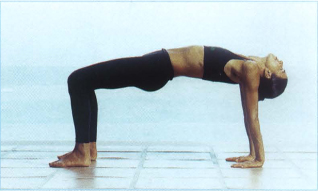
Connecting Vinyasa
On the fifth exhalation, lower your hips back down to a seated position in preparation for Fish pose.

Tabletop, modification
Pose 50: Fish Pose (Matsyasana)
Fish pose is a wonderful and powerful counterbalancing pose that releases the muscles in the back and reopens the throat, chest, and entire front side of the torso, bringing the body back into balance. This pose also helps to redirect the blood flow through the thyroid and parathyroid glands.
Building Blocks: From a seated position, place your hands under your sitting muscles, palms facing down. Lean back until your forearms are down on the floor. Walk your elbows and forearms in toward each other, shimmy your shoulder blades in toward each other. On the inhale, raise your heart muscle high and arch your back, lower your head back and slide back until the crown is resting on the floor. Create a big, beautiful bend in your upper back, opening your throat and heart to the heavens. Root your shoulders down and away from your ears and lift through your chest. (As in Camel, your shoulder blades are like giant hands pressing your chest upward.) Point your toes and activate your thighs. This stretch should feel so good!
Gaze to a point on the wall behind you and breathe deep for five inhalations and exhalations. Fill your lungs completely with sweet oxygen so your entire being is full of breath, full of life. After the fifth exhalation, inhale, lift your head up, tuck your chin, slowly release your arms, and lower back down to a horizontal resting position.
Modification: If you have pain or strain in your neck, try working with your head off the floor, chin at your chest.
Spiritual Focus: Speaking from your heart comes from a single-minded attention to your intuition in the moment. From this inner space springs forth a steady flow of honesty and insight. When we are upset, we lose our focus, and our speech no longer flows gracefully from the ground of our being.
Fish pose stimulates and opens the throat and heart area—the energy center of self-expression and intuition. Inspiration may burst forth, or you may suddenly become aware of truths you have not been speaking, either to yourself or others. Give conscious attention to whatever arises.
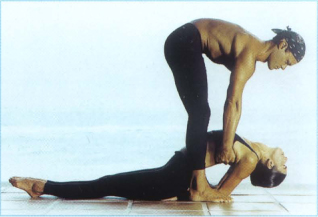
Pose 50: Fish (assisted)
Connecting Vinyasa
Release your arms and lie on your back with your arms resting by your sides. You are now ready for the final part of the practice, Surrender to Gravity.
11. Surrender to Gravity Series: Deep Rest
The Surrender to Gravity Series is the closing sequence of the practice. You’ve made it! You have done your part in this practice; now it’s just time to let go and let the universe meet you halfway. You’ve allowed a lot to happen just by opening up honestly, by challenging yourself to be more, by breathing deeply, by letting go of all the games and headstuff you originally brought with you to the mat. You’ve crossed the rivers of resistance in your mind, challenged yourself to climb emotional and spiritual mountains. And now, as Goethe promised centuries ago, “Over all the mountain tops is peace.”
There are three poses in the Surrender to Gravity sequence: Dead Bug pose, Supine Twist, and the final resting pose, Savasana.
Pose 51: Dead Bug Pose (Urdhva Mukha Upavista Konasana)
Dead Bug pose gives a final stretch to the hips, hamstrings, and inner thighs, and also releases the lower spine. It slows the heart rate and brings the body to a restorative and resting state. You are completely supported here by gravity.
Building Blocks: From a horizontal prone position, inhale and bring your knees up to your chest. Grab the inner edges of your feet, thumbs facing down toward your heels. Very gently pull your feet, knees, and quadriceps toward the floor. Your ankles should be stacked directly over your knees. Roll your tailbone down toward your mat and lengthen your spine into the floor. You should feel a release in your spine and a good stretch in your hips, inner thighs, and hamstrings.
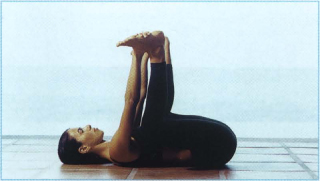
Pose 51: Dead Bug
Allow your belly to drop. Now just relax into infinite awareness and breathe. Be really still. . . be really dead! Be the poster child for Raid! After five breaths, hug your knees back into your chest and stay here in preparation for the next pose, Supine Twist.
Spiritual Focus: You can’t grab the next trapeze until you release the present one. Just let go!
Pose 52: Supine Twist
This final twist rinses away any remaining tension. It integrates everything you’ve done by balancing and releasing on every level. It flushes the middle of the body and spine with nutrient-rich blood and helps to soothe a restless and emotional mind, inviting a new sense of serenity and peace.
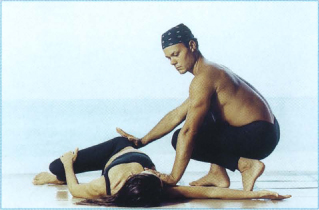
Pose 52: Supine Twist (assisted)
Building Blocks: Straighten your left leg on the floor and pull your right knee into your chest. Exhale and spin your right knee over to the outer left side of your body. Open your right arm out like a wing and look over your right shoulder. Close your eyes and just rest. There is nothing else to do now but surrender.
Breathe deeply into the lower abdominal and pelvic cavities. Breathe into the lower back and kidney area. Ring out your spine and vital organs like a sponge. This is your time to cleanse and release. On the inhalation, breathe in that crystal-clear, purifying wind. On the exhalation, breathe away all the toxins and impurities.
After five breaths, bring your right leg back to center on the next inhalation. Reverse your legs and take another five breaths with your right leg extended. Return to center, hug both knees into your chest—go ahead, give them a good squeeze—and then release them both down to the floor. Relax like never before.
Risk Factor: Don’t force the twist and strain your back; be gentle.
Modification: If this twist is too intense for your middle or lower back, move your bent knee down lower, toward the extended foot. Or if you need to, bend both knees and twist to the side with them pressed together. This will dilute the intensity of the movement.
Spiritual Focus: We tend to think that surrender is giving up our power. But surrender is anything but passive. It isn’t throwing away our power. It’s expanding it through faith and a willingness to let go of all we think we know . . . all we struggle to do . . . all we believe we need to accomplish.
Pose 53: Savasana
Savasana, which we refer to by its Sanskrit name only, signals the end of the asana practice and the gateway to a deeper, meditative state—a new beginning. Deeper rest shifts the brainwaves into the alpha state—the state of creativity, spiritual awakening, and peak performance. Even the smallest taste of this sensation rewires us toward a healthier and more powerful mode of being.
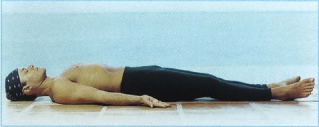
Pose 53: Savasana
Building Blocks: Lie on your back with your legs straight and separated about twelve inches apart. Let your feet relax and splay out. Place your arms alongside your body, about six inches away from you, palms facing up. Roll your shoulder blades in toward each other—this allows your chest to expand and your breathing to shift profoundly. Pull your head out of your neck, your arms away from your shoulders, and your legs away from your hips. Lengthen your spine into the floor but allow the curvatures to take their natural form. Really feel the floor beneath you and your contact with it. Make whatever adjustments you need to feel comfortable here and let go. With every breath let your body fall deeper into the floor.
You’ve done your part. You’ve met the universe halfway. Now let every fiber of every muscle relax and release, and let magic happen. Close your eyes and just be still. Let go of your thoughts. It’s just you and your breath now. Nowhere to go. Nowhere else to be but here now, in this moment. Nothing left to do but surrender. Just bask in your healing yogic glow and know that there is nothing more important than this moment and your own authentic, radiant being.
Stay here for as long as you like. Ideally ten to twenty minutes, to let your nervous system assimilate all the good you have done in your practice.
Modification: If your lower back aches, set your feet flat on the floor and/or prop up your torso with blankets. You can also place a rolled-up blanket under your knees.
Spiritual Focus: When you fully embrace this moment as an opportunity to heal, you tap into an energy that pushes you forward in physical endeavors. Our ultimate achievement comes not from what we do, what we accomplish, or what we accumulate, but rather from who we are—and that can change simply by having an internal shift. True success is not about anything more than truly living a life that works on all levels, not just for us, but for the world.
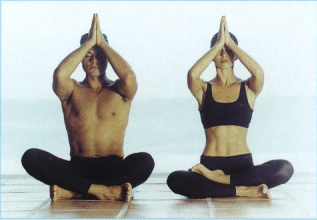
Closing Sequence
To Close Your Practice
Keep your eyes closed throughout this movement. When you are ready, roll onto your right side from Savasana into a fetal position with your knees to your chest. Stay here for as long as it feels right, then very slowly come up to a seated, cross-legged position. Bring your hands together in a prayerlike position at your heart center for a minute of stillness. If you’d like, you can chant “om” three times deeply as a way to create a peaceful harmony in your breathing and hormonal systems.
Then slowly bring your hands up to your third-eye center at your forehead. Breathe and invite in the light. We end all our practices by quietly saying “namaste,” an acknowledgment of the light in ourselves and in all those around us.
Integration Series
Sun Salutation A
Sun Salutation B
On the third round of Sun Salutation B, add Warrior II after Warrior I and end the vinyasa in Samastithi.
Warrior Series
Balancing Series
Triangle Series
Backbending Series
Abdominal Series
Inversions
Hip Series
Forward Bends
Surrender to Gravity
I recognize that not everyone has ninety minutes every day to practice yoga, and that some days you will need to tailor your practice to fit into your schedule. Here is the formula to use when creating your modified practice.
You can choose which series to do based on how your energy feels, or on what you physically or emotionally feel you need that day, or a combination of the two. For example:
One note of caution: If you can only do modified practices, try to vary the series you do from day to day. You don’t want to concentrate on only one part of the body. Yoga is a global exercise that is meant to work the entire body, and overdeveloping one area is no better than ignoring another entirely.
Don’t skip your practice altogether just because you don’t have time to do a full ninety minutes, or try to do more than ninety minutes when you have the time. Remember, it’s better to do a little bit of yoga often if you are unable to do a full, well-rounded practice consistently.